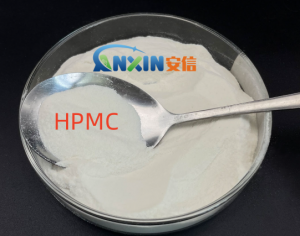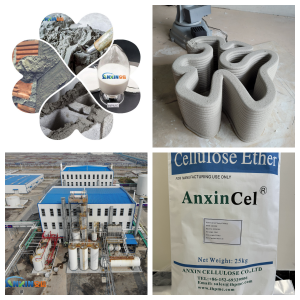Hydroxypropyl methylcellulose (HPMC), a high-molecular-weight nonionic cellulose ether, is widely used in construction, coatings, and building materials systems. Especially in cement-based materials, HPMC has a significant regulatory effect on the hydration reaction, influencing the hydration rate, product morphology, pore structure, and final mechanical properties of cement paste.
1. Physicochemical Properties and Mechanism of Action of HPMC
HPMC is modified from natural cellulose through methylation and hydroxypropylation reactions, exhibiting good water solubility and surface activity. Its molecular chain is rich in hydroxyl groups and ether bonds, enabling it to form a stable solution in water, possessing film-forming, water-retaining, thickening, and dispersing properties. When HPMC is added to cement paste, the molecules adsorb onto the surface of cement particles, forming a polymeric film. The presence of this film hinders the diffusion of water into the particle interior, thereby slowing down the initial rate of the cement hydration reaction.
The molecular chains of HPMC partially dissociate under alkaline conditions, altering the viscosity and interfacial properties of the solution and creating a “physical barrier effect.” This effect not only affects ion transport but also allows for effective control of the hydration process by adjusting the timing of the hydration heat peak.
2. The Influence of HPMC on the Hydration Process
2.1. Delaying the Initial Hydration Reaction
The addition of HPMC prolongs the induction period of cement hydration. This is mainly because HPMC adsorbs onto the surface of cement particles, reducing the direct contact area between water and clinker minerals (such as C₃S and C₃A). Simultaneously, the HPMC film inhibits the diffusion of ions such as Ca²⁺ and OH⁻, reducing the hydration reaction rate. Caloric measurements show that with increasing HPMC addition, the hydration exothermic peak is delayed and its peak value decreases, exhibiting significant retarding characteristics.
2.2. Improved Mid-to-Late Stage Hydration Structure
Although HPMC delays initial hydration, its excellent water retention properties allow for full utilization of internal water in the mid-to-late stages, ensuring the continued hydration reaction. This slow-release effect helps generate more uniform and dense hydration products, reducing capillary porosity and improving the volume stability and crack resistance of the mortar.
2.3. Influence on the Morphology and Distribution of Hydration Products
Scanning electron microscopy (SEM) revealed that the calcium silicate hydrate (C–S–H) gel generated after HPMC incorporation is finer and more continuous. Simultaneously, cellulose molecules may act as templates or spatial networks, inducing the growth of hydration products along specific directions, thereby optimizing the microstructure and improving the strength of the interfacial transition zone (ITZ).
3. Effects of HPMC Concentration and Molecular Properties on Hydration Regulation
The regulatory effect of HPMC on hydration is closely related to its dosage, degree of substitution (DS), and viscosity grade.
Dosage Influence: Generally, HPMC dosage within the range of 0.05%–0.3% produces a significant retarding effect; excessive dosage may lead to severe hydration inhibition and decreased early strength.
Substitution Degree Influence: The ratio of methoxy to hydroxypropoxy groups determines the hydrophilic/hydrophobic balance of HPMC. Higher methoxy content enhances molecular hydrophobicity and a more significant water-blocking effect; while higher hydroxypropoxy content enhances water retention and wetting ability, resulting in a gentler regulation of the hydration reaction.
Viscosity Influence: High-viscosity HPMC forms a stronger spatial network structure in the slurry, restricting water migration and ion diffusion, thereby intensifying the retarding effect; low-viscosity types mainly play a role in water retention and rheological regulation.
4. Engineering Performance and Application Significance
The hydration-regulating effect of HPMC is directly reflected in material properties:
Improved workability: The thickening and water-retention effects of HPMC improve the workability and anti-sagging properties of mortar during construction;
Enhanced durability: Delayed hydration helps reduce heat of hydration and prevents early thermal stress cracking;
Strengthened interfacial bonding: By forming a flexible organic film, it improves the interfacial bonding between the mortar and the substrate;
Optimized pore structure: Uniform hydration refines the pore size distribution, thereby improving impermeability and frost resistance.
HPMC significantly influences the cement hydration process through multiple mechanisms, including adsorption, hydration film formation, and ion diffusion inhibition. Its effects are not only manifested in the initial retarding effect but also in later structural optimization and durability improvement. Appropriate selection of the degree of substitution and dosage of HPMC can achieve a balance between workability and mechanical properties, providing an important basis for the design of high-performance cement-based materials.
Post time: Nov-06-2025








